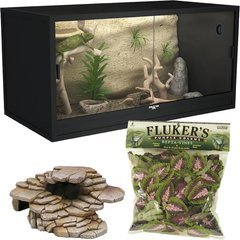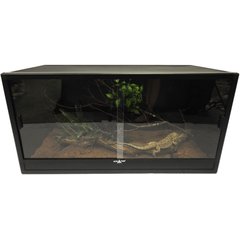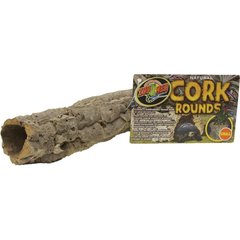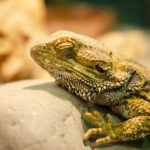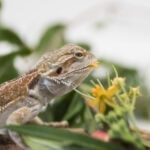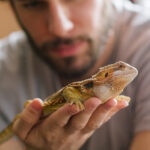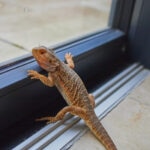How Big Can a Bearded Dragon Get? A Guide to Your Beardie’s Size
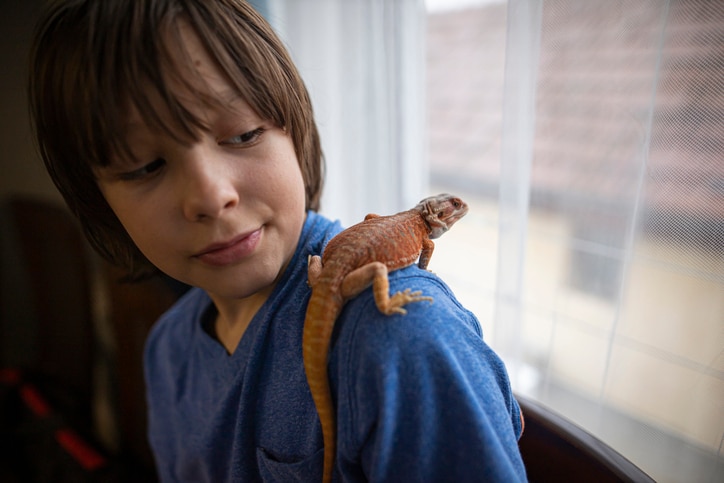
Photo by Dusan Stankovic/iStock/Getty Images Plus
That cute little baby beardie you brought home won’t stay small forever. But how big does a bearded dragon get?
Read on to learn all about their size—from hatchling to adult—and what they need to reach their full potential.
Key Takeaways
- A pet bearded dragon’s size depends on genetics, diet, and habitat during their first two years.
- Adult central bearded dragons typically reach 18–24 inches long and weigh 300–550 grams.
- Proper UVB lighting, nutrition, and enclosure size are essential for healthy growth.
- Monitor your beardie’s weight and body condition; a balanced diet prevents both obesity and undernourishment.
What Determines a Bearded Dragon’s Size?
In the wild, sizes vary depending on species, gender, and overall health.
“A bearded dragon’s maximum size, in my opinion, is determined by two things: genetics and diet throughout the first two years of their life,” says Scorchin’ Scalies owner Austin Guinn.
There are eight species of bearded dragons found in Australia, according to Denise Cieri, founder of HerpHaven Reptile Rescue and Sanctuary in Brunswick, Maine. But most aren’t available as pets in the U.S.
The most common pet species by far is the central bearded dragon. Here’s what influences their size:
- Genetics: A dragon’s genetic makeup affects their size—the same as people.
- Male vs. female: Central bearded dragon males tend to be bigger. They usually have bigger heads, bigger tails, and a bigger cloacal opening.
- Diet: A beardie that eats a balanced, healthy diet has a better chance to grow bigger.
- Living conditions: Their habitat can also affect their growth. A beardie that gets plenty of healthy UVB from proper bulbs or sunshine and lives in a clean, enrichment-filled enclosure will stay healthier and be able to reach their full potential.
How Big Does a Bearded Dragon Get?
The most common beardies—central bearded dragons—are usually around 18 to 20 inches long and weigh about 300 to 500 grams, explains Cieri. “That’s really just an average—I’ve seen adult beardies that were around a foot in length and weighed about 200 grams as full adults.”
However, both Guinn and Cieri have seen outliers—some over 1,000 grams in weight and 30 inches long.
Central bearded dragon size by age:
- Hatchling (0–2 months): 2–3 inches long
- Juvenile (3–11months): 4–12 inches
- Sub-adult (12–18 months): 12–18 inches
- Adult (over 18 months): 21–24 inches
Some bearded dragon parents start with the largest enclosure possible, at least 4x2x2, so that they don’t have to upgrade later on as their beardie grows. This will help them not feel cramped as they grow, and it will save you time and money rearranging your home to fit a new enclosure as they grow.
However, it’s important to note some baby beardies have trouble catching insects in an enclosure that’s too large, so if you do have a large space, make sure they’re able to eat their meals and not go hungry.
On the other hand, if you do start out with a smaller enclosure for a baby beardie to make sure they’re grabbing their grub, upgrade regularly as your beardie grows to make sure they have the appropriate amount of space for their size.
Recommended Products
All enclosures should contain naturalistic decor that offers enrichment opportunities.
Recommended Products
What’s a Good Weight for Your Bearded Dragon?
Bearded dragons enjoy eating and can easily become overweight or obese.
Most adult bearded dragons weigh between 300 and 550 grams. You’ll need to make sure your bearded dragon’s diet is balanced and doesn’t contain too much fruit; the right amount of nutrients at the right time will make all the difference.
One of the first signs your beardie may be overweight is that you can’t feel their spine or ribs when you rub a finger down their body. Here are a few more signs your bearded dragon has had too many snacks:
- Oversized fat pads all over their body—armpit, tail, jowls, etc.
- Sluggishness
- Difficulty climbing
- Distended belly
- Fat tail
- Excess skin folds
In contrast, if you are worried that your bearded dragon is too thin, here’s what to look for:
- Oversized head
- Skinny legs
- Skinny tail
- Visible hips and ribs
- Sagging skin across the chest
- Sunken eyes
- Diminished fat pads
Whether over or underweight, enlist the help of your exotic reptile veterinarian to help get back on track.
While your beardie’s genetics are a big part of how big your dragon will grow, it’s also a reflection of how you care for them. By providing the right setup and nutrition, you can help your beardie grow as big and healthy as they can.
FAQs About Bearded Dragon Size
How big should a bearded dragon tank be?
A 120-gallon enclosure is good for your beardie’s forever home. Make sure there are lots of basking spots and enrichment too.
How often should your bearded dragon go to the vet?
Your dragon should see the vet yearly and whenever you suspect health concerns.
How big is a 1-year-old bearded dragon?
At a year old, most bearded dragons are around 10 inches long, though it can vary by species and gender.
Can bearded dragons outgrow their habitats?
Yes. If you started with a small enclosure when your buddy was little, your beardie will absolutely outgrow their habitat and you need to upgrade.
